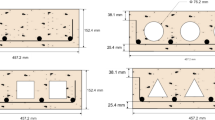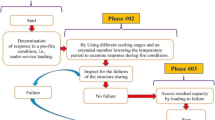Abstract
Corrosion of reinforced concrete (RC) structures is one of the significant causes of deterioration of reinforced concrete (RC) structures. Chlorination is a major process governing the initiation and advancement of the injurious corrosion of steel bars. Now, several researches on the chlorination of concrete structures have been ongoing around the world. Present article reviews several recently performed chlorination studies, and from results of a field survey evaluates the effect of chloride content on the probability of corrosion and the influence of concrete compressive strength on the chloride content and penetration, also evaluates the effect of concrete cover over the chloride content of the RC structures at rebar depth and on the probability of corrosion.
Similar content being viewed by others
Refrerences
Wardhana K, Hadipriono F C. Analysis of recent bridge failures in the United States. Journal of Performance of Constructed Facilities, 2003, 17(3): 144–150
Li G P, Hu F J, Wu Y X. Chloride ion penetration in stressed concrete. Journal of Materials in Civil Engineering, 2011, 23(8): 1145–1153
Costa A, Appleton J. Chloride penetration in marine environment—part I: Main parameters affecting chloride penetration. Materials and Structures, 1999, 32(4): 252–259
Cusson D, Lounis Z, Daigle L. Durability monitoring for improved service life predictions of concrete bridge decks in corrosive environments. Comp Aid Civil and Infr Eng, 2011, 26: 1–40
Balafas I, Burgoyne C J. Modeling the structural effects of rust in concrete cover. Journal of Engineering Mechanics, 2011, 137(3): 175–185
Yuan Q, Shi C, De Schutter G, Deng D, He F. Numerical models for chloride penetration into saturated concrete. Journal of Materials in Civil Engineering, 2011, 23(3): 305–311
Wang H, Lu C, Jin W, Bai Y. Effect of external loads on chloride transport in concrete. Journal of Materials in Civil Engineering, 2011, 23(7): 1043–1049
Chai W, Li W, Ba H. Experimental study on predicting service life of concrete in the marine environment. Open Civil Eng J, 2011, 5: 93–99
Zhang W, Ba H. Accelerated life test of concrete in chloride environment. Journal of Materials in Civil Engineering, 2011, 23(3): 330–334
Lin G, Liu Y, Xiang Z. Numerical modeling for predicting service life of reinforced concrete structures exposed to chloride environments. Cement and Concrete Composites, 2010, 32(8): 571–579
Sun Y, Chang T, Liang M. Service life prediction for concrete structures by time-depth dependent chloride diffusion coefficient. Journal of Materials in Civil Engineering, 2010, 22(11): 1187–1190
Andrade C, Andrea R. Electrical resistivity as microstructural parameter for the modeling of service life of reinforced concrete structures. In: Proceedings of the 2nd Int Sym on Ser Life Des Inf-2010. Delft Netherlands, 2010, 379–388
Wang C J, Zhang G Z, Liu K X, Tu L Q, Li J H, Qin M Q. Research on service life prediction model of concrete structure on sea crossing bridge. J Wuh Univ Tech, 2010, 32(17): 141–146
Conciatori D, Laferriere F, Bruhwiler E. Comprehensive modeling of chloride ion and water ingress into concrete considering thermal and carbonation state for real time. Cement and Concrete Research, 2009, 40(1): 109–118
Song H, Kwon S. Evaluation of chloride penetration in high performance concrete using neural network algorithm and micro pore structure. Cement and Concrete Research, 2009, 39(9): 814–824
Zhang J Y, Lounis Z. Nonlinear relationship between parameters of simplified diffusion-based model for service life design of concrete structures exposed to chlorides. Cement and Concrete Composites, 2009, 31(8): 591–600
Cheung M M S, Zhao J, Chan Y B. Service life prediction of RC bridge structures exposed to chloride environments. Journal of Bridge Engineering, 2009, 14(3): 164–178
Alizadeh R, Ghods P, Chini M, Hoseini M, Ghalibafian M, Shekarchi M. Effect of curing conditions on the service life design of RC structures in the persion gulf region. Journal of Materials in Civil Engineering, 2008, 20(1): 2–8
Shekarchi M, Ghods P, Alizadeh R, Chini M, Hoseini M. Durapgulf a local service model for the durability of concrete structures in the south of Iran. Arab J Sci Eng, 2008, 33(1B): 77–88
Anoop M B, Balaji Rao K. Application of fuzzy sets for remaining life assessment of corrosion affected reinforced concrete bridge girders. Journal of Performance of Constructed Facilities, 2007, 21(2): 166–171
Evans C, Richardson M G. Service life of chloride-contaminated concrete structures. Concrete Res in Ireland Colloquium, 2005, 131-137
Polder R B. Rooij MRd. Durability of marine concrete structures-field investigations and modeling. HERON, 2005, 50(3): 133–153
Khatri R P, Sirivivatnanon V. Characteristics service life for concrete exposed to marine environments. Cement and Concrete Research, 2004, 34(5): 745–752
Martin-Perez B, Lounis Z. Numerical modeling of service life of reinforced concrete structures. Proceedings of 2nd Int. Rilem w/s on Life Pred Ag. Mang 2003, Paris, France, 71–79
Liang M, Lin L, Liang C. Service life prediction of existing reinforced concrete bridges exposed to chloride environment. J Infra Sys, 2002, 8(3): 76–85
Cao H T, Sirivivatnanon V. Service life modelling of crack-freed and cracked reinforced concrete members subjected to working load. CIB world building congress, Wellington New Zealand, 2001, 1–11
Scheremans L, Gemert D V. Service prediction of reinforced concrete structures, based on in-service, chloride penetration profiles. Dur Build Mat Comp, 1999, 8: 83–93
Costa A, Appleton J. Chloride penetration in marine environmentpart II: prediction of long term chloride penetration. Materials and Structures, 1999, 32(5): 354–359
Ann K Y, Ahn J H, Ryou J S. The importance of chloride content at the concrete surface in assessing the time to corrosion of steel in concrete structures. Construction & Building Materials, 2009, 23(1): 239–245
Sharma S, Mukherjee A. Monitoring corrosion in oxide and chloride environments using ultrasonic guided waves. Journal of Materials in Civil Engineering, 2011, 23(2): 207–2011
Sengul O, Tasdemir M A. Compressive strength and rapid chloride permeability of concretes with ground fly ash and slag. Journal of Materials in Civil Engineering, 2009, 21(9): 494–01
Author information
Authors and Affiliations
Corresponding author
Rights and permissions
About this article
Cite this article
Verma, S.K., Bhadauria, S.S. & Akhtar, S. Evaluating effect of chloride attack and concrete cover on the probability of corrosion. Front. Struct. Civ. Eng. 7, 379–390 (2013). https://doi.org/10.1007/s11709-013-0223-9
Received:
Accepted:
Published:
Issue Date:
DOI: https://doi.org/10.1007/s11709-013-0223-9




